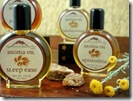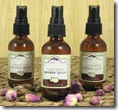Posts Tagged: essential oils
What Is That Wonderful Scent?
My Mother would spray Lysol® in our home all the time while I was growing up. It’s purpose is to clean, disinfect and remove odors. I remember getting a headache if I walked into the “cloud” as she sprayed. I also remember the perfume my Mother wore, Chanel #5 and later Liz Claiborne. I know that if a stranger walked by wearing either fragrance today, I would stop and thoughts of my Mother would bring a smile to my face (and then I would probably sneeze!). When I think of Christmas time, I immediately have aromatic thoughts of the scent of cookies baking, applesauce on the stove top simmering with cinnamon and the smell of the freshly cut pine tree in our living room. Whether I smell the fragrance or think of a setting, scent is a very important aspect of my memories and feelings regarding my surroundings. When I am designing spaces for my clients, I like to think that I am helping to create beautiful visual spaces for them to live in along with touching upon their other senses for a full experience.
As I have shared in past blog postings, I have learned that I have chemical sensitivities to certain products out-gassing within my living and working environments. I have also realized that “perfumes” and certain fragranced products give me headaches as well. Once I discovered essential oils about 6 years ago as an alternative to perfumes, I was able to wear scents again and I also learned how to incorporate these essential oils into my environments through aromatherapy.
Aromatherapy may have origins in antiquity with the use of infused aromatic oils, made by macerating dried plant material in fatty oil, heating and then filtering. Aromatherapy is a form of alternative medicine that uses volatile plant materials, known as essential oils, and other aromatic compounds for the purpose of altering a person’s mood, cognitive function or health. Distilled essential oils have been employed as medicines since the invention of steam distillation in the eleventh century. The effectiveness of aromatherapy is yet to be scientifically proven, however some evidence exists that essential oils may have therapeutic potential.
The modes of application of aromatherapy include:
- Aerial diffusion: for environmental fragrancing or aerial disinfection
- Direct inhalation: for respiratory disinfection, decongestion, expectoration as well as psychological effects
- Topical applications: for general massage, baths, compresses, therapeutic skin care
An essential oil diffuser enables you to diffuse essential oils throughout your home or office. Diffusing is a simple and effective way to use essential oils. I use an air pump diffuser model for diffusing oils in my home and office. With a diffuser, oils are dispersed in a micro-fine vapor, allowing them to remain suspended in the air for extended periods of time. The diffuser disperses the oils without heating them so they retain their natural benefits. You can leave the diffuser on for a few minutes or for several hours. When inhaled, the oils are easily absorbed through the lungs. Depending on the oil used, diffusing can cleanse the air of odor, calm one’s mood and possibly help in one’s health regimen.
Essential oils that are inhaled into the lungs offer both psychological and physical benefits. Not only does the aroma of the natural essential oil stimulate the brain to trigger a reaction, but when inhaled into the lungs, naturally occurring chemicals may supply therapeutic benefits. Diffusing eucalyptus essential oil to help ease congestion is a great example.
Essential oils are natural and contain the true aromatic essence and other naturally beneficial properties of the plant the essential oil was distilled from. Essential oils are not the same as fragrance oils, perfume oils or potpourri oils. Essential oils contain only the distilled essence of a plant, perfume and fragrance oils are artificially created fragrances, containing artificial substances or are diluted with carrier oils and do not offer the benefits that essential oils offer. Look for products that contain pure essential oils on their ingredient list and avoid those that have words like fragrance. Some sellers of good-quality aromatherapy blends do not list their ingredients because they are worried that others may copy their creation. Good suppliers should be happy to provide you with a list of the ingredients. They understand that some individuals must avoid particular oils due to health problems.
General Household Freshening – Add a few drops of essential oil to your trash can, laundry wash, drain, vacuum bag filter, or on a tissue for placement in your drawers.
Bug Repellent – Many essential oils including citronella, lavender, and peppermint act as a natural repellent against insects.
When thinking about the interior air quality of our environments, I believe that using products that employ natural essences compared to artificially created fragrances are a must. If you are interested in learning more about aromatherapy, purchasing an oil diffuser, or other questions related to interior design, please contact me at [email protected] or call me at 978-335-1140.
Here are a few of my favorite companies for essential oils and their other offerings:





